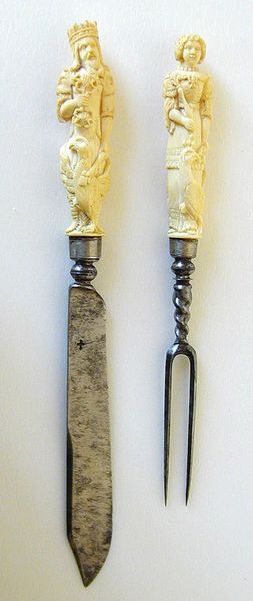Knife, Fork, Spoon
-dining (small).jpg) Dinner scene from The Luttrell Psalter,
Dinner scene from The Luttrell Psalter,
(c.1325-40), Lincoln, England[?]
The British Library
A table laid in the modern way and our present table manners are the results of many details that custom has imposed slowly, one by one, and in ways that vary according to region. Spoon and knife are fairly old customs. However, the use of a spoon did not become widespread until the sixteenth century and the custom of providing knives dates from the same time – before that the guests brought along their own. Individual glasses for each guest also appeared at about this time. Courtesy formerly dictated that one emptied the glass and passed it on to one’s neighbour, who did the same. […]
The individual fork dates from about the sixteenth century; it spread from Venice and Italy in general, though not very quickly. A German preacher condemned it as a diabolical luxury: God would not have given us fingers if he had wished us to use such an instrument. We know that Montaigne did not use a fork, since he accuses himself of eating too quickly so that ‘I sometimes bite my fingers in my haste’. Indeed he says he rarely ‘makes use of spoon or fork’. […] Their use only became general in about 1750. Anne of Austria ate her meat with her fingers all her life. And so did the Court of Vienna until at least 1651.
—Fernand Braudel, The Structure of Everyday Life (1979), pp. 205-6.
